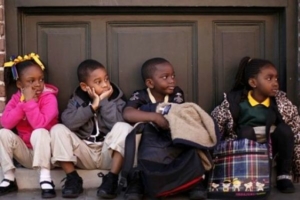The Lottery

The notice reaches my inbox on a Friday evening in March, and a mix of anticipation and dread wash over me. The website lags after I enter my login credentials. When the site finally loads, I navigate to the lottery results page. My heart sinks when I see that my daughter is #28 and #66 on the two magnet school waiting lists. She’s not getting in this year.
* * *
When my daughter grows up, she wants to be a scientist and a fashion designer. Some days she also wants to be a YouTube star and/or the first Black woman president. I will measure my success as a parent largely by my ability to give her the tools and opportunities she needs to make one or more of those dreams happen. (Okay, maybe not the YouTube thing.) But the annual struggle to find a school suited to that task feels like a generational curse we can never escape. As a third-generation college graduate who’s halfway to her second master’s degree, most would assume that my child’s academic achievement was a foregone conclusion. Nevertheless, I’m fighting a battle for educational equity that the history books claim we won before I was born.
This year, like the previous two years, I applied to the electronic lottery for the Math & Science and Performing Arts magnet schools in our county. Magnet schools got their names because their specialized programs “attract” students from outside their normal geographic boundaries. Filling out a form for the electronic lottery is a much more dignified process than the one my parents underwent when they camped out overnight to get me into a Spanish-language magnet school. But technological advancements aside, I still find myself trying to escape underperforming neighborhood schools more than thirty years later.
In kindergarten, my daughter had a succession of mostly non-certified substitutes after her homeroom teacher had to take personal leave for half the school year. This happened again in the first grade when her reading and language arts teacher quit a few months into the school year. In those two years, the students never went on a field trip, infrequently had recess, and languished in crowded classrooms that did not allow for consistent individual attention. Despite these shortcomings, I feel torn as I write this because the teachers and staff are, for the most part, dedicated professionals who care about my child. On top of that, the principal is under near constant threat of removal if she doesn’t increase test scores.
I’m fighting a battle for educational equity that the history books claim we won before I was born.
But that scarcity and external pressure can take their toll on school climate. My daughter and her classmates regularly had “privileges,” like being allowed to talk during lunch or going to recess, taken away due to some student or another’s misbehavior. Every time she came home and told me about being reprimanded for talking during “silent lunch,” I seethed. When she lamented that the experiment they planned to do in science class didn’t happen because there were too many students and not enough time, I despaired. And when she dejectedly admitted to not getting a prize in the teacher’s arbitrary rewards system for doing things like blowing her nose too much or rolling her eyes, I ranted.
Black folks love to remind each other, “If you’re not part of the solution, you’re part of the problem.” The implication is that only those with the time or resources to get involved have the right to expect a quality education for their child. So I volunteer in the classroom, serve on the PTA, and communicate regularly with the teacher. But my active involvement and our efforts to supplement her learning outside of school do little to quell the anxiety that my child, and all of the children in our community, are being shortchanged.

* * *
On a sweltering Saturday morning, my daughter and I hop in the car and take a short drive up the street to our church. They’re having the “Ujamaa Exchange,” a regular event inspired by the Kwanzaa principal of Cooperative Economics. Members of the congregation and the community can donate their gently used items and take whatever they need for free. I drop off some business suits I no longer wear and retreat under a tent to fellowship with friends. My daughter runs off to join other kids on the playground.
Black folks love to remind each other, “If you’re not part of the solution, you’re part of the problem.” The implication is that only those with the time or resources to get involved have the right to expect a quality education for their child.
When we can’t take the heat any longer, we say our goodbyes and head to the library. One of the librarians recognizes us from the many community meetings we attend there. She and I chat while her colleague helps my daughter hunt for a Fancy Nancy book she hasn’t read yet.
When people suggest that we move to an area with “better schools,” this is what we would be giving up. The social capital we have established here provides an invaluable safety net of sister friends, big brothers, babysitters, play cousins, “aunties,” mentors, and allies. Moving to a better school district would mean leaving behind a community where seeing Black leaders, business owners, and even law enforcement, is commonplace for my child. And in the current political climate, it means exposing her to a much higher likelihood of overt racism, on top of the well-documented racial disparities that have long plagued Black students.
Yet, this is a choice that many Black parents I know have made for their children. And I get it. Education is supposed to be “the great equalizer,” but the American Academy of Pediatrics’ recent findings bear out what many of us have always known: that exposure to racism causes “toxic stress” that can lead to significant negative effects on the achievement and health of Black children. That’s a price I am unwilling to pay just to find a “good school.”
 Even at the higher-performing “traditional theme schools” in my area, the pressure to achieve and internalized racism among the mostly Black staff and parents seem to be a recipe for harshness and rigidity. The School Board gives them more leeway to establish their own policies, like strictly enforced uniforms, a required level of parental involvement, onerous amounts of homework, and restrictions on how students can wear their hair. In exchange for what one alumna called a prison-like environment, parents get peace of mind and marginally better test scores than the nearby neighborhood schools.
Even at the higher-performing “traditional theme schools” in my area, the pressure to achieve and internalized racism among the mostly Black staff and parents seem to be a recipe for harshness and rigidity. The School Board gives them more leeway to establish their own policies, like strictly enforced uniforms, a required level of parental involvement, onerous amounts of homework, and restrictions on how students can wear their hair. In exchange for what one alumna called a prison-like environment, parents get peace of mind and marginally better test scores than the nearby neighborhood schools.
But at what cost? Teaching Black children the myth that wearing “respectable” hairstyles and clothing will protect them from racism? Stifling any sense of creativity or personal expression in favor of compliance?
Moving to a better school district would mean leaving behind a community where seeing Black leaders, business owners, and even law enforcement, is commonplace for my child […] it means exposing her to a much higher likelihood of overt racism, on top of the well-documented racial disparities that have long plagued Black students.
It shouldn’t be too much to expect that my child could attend a school where her individual personality and cultural identity are celebrated rather than stifled. Where educators understand that time to socialize, be physically active, and engage in unstructured play are crucial to children’s development. Where teachers cultivate intrinsic motivation and critical thinking instead of transactional learning that teaches them to memorize information for external validation.
It almost sounds ridiculous to say out loud that I want my daughter to excel academically—not to impress her teachers or please her parents—but because she feels genuinely engaged in and responsible for her own learning. And perhaps an even more absurd desire is that I would not have to compete with fellow members of my community to access this quality education. If we could all send our children to a school like that, we truly will have won the lottery.
A.D. Lowman is a management professional, consultant, and community leader. Her leadership and career advice has been featured in Essence, Money, and Diversity Woman magazines. She is pursuing her MFA in Creative Writing at Antioch University Los Angeles where she serves as an Associate Managing Editor and blogger for Lunch Ticket.





